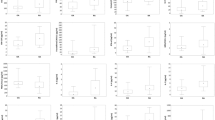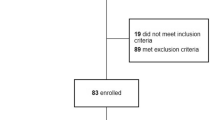Abstract
In our previous studies, we found higher synovial fluid (SF) levels of angiogenic ELR(+) CXC chemokines such as CXCL1, CXCL5, CXCL6 and CXCL8, which play an important role in neutrophil migration and angiogenesis, and more abundant synovial CXCR2 chemokine receptor expression in patients with rheumatoid arthritis (RA) than those with Behçet’s disease (BD), familial Mediterranean fever and osteoarthritis (OA). As a continuation of our previous studies, we investigated synovial levels of angiostatic non-ELR CXC chemokines (CXCL4, CXCL9 and CXCL10) in patients with RA, BD, spondyloarthritis (SpA), and OA. Seventy (17 RA, 15 BD, 19 SpA, and 19 OA) patients were enrolled in the study. The levels of CXCL4, CXCL9, and CXCL10 were measured by ELISA. The SF levels of CXCL4 in patients with RA were higher than those of the patients with BD, SpA, and OA (P = 0.007, P = 0.022, and P = 0.017, respectively). No difference was found with respect to CXCL4 levels among the BD, SpA, and OA patients. The synovial CXCL9 levels of patients with RA and SpA were found to be higher than those of the patients with OA (P = 0.002 and P = 0.005, respectively), while no statistically significant difference was detected among the other groups. With regard to SF CXCL10 levels, patients with RA had higher levels as compared to patients with OA (P = 0.002), but no significant difference was found among the other groups. CXCL9 correlated with CXCL4 and CXCL10 (P < 0.05 for both) in patients with RA. No correlation was found in other parameters. The angiostatic non-ELR CXC chemokines were expressed in synovial inflammation. We proposed that angiostatic non-ELR CXC chemokines may increase to balance angiogenic ELR (+) CXC chemokines in which increased levels were shown in patients with inflammatory arthritides and CXCL4 may contribute to designate the chronicity of synovitis in patients with RA. In addition, as CXCL-9 and CXCL-10 play crucial role in inflammation characterized by Th1 polarization, we suggested that they may contribute to the commencement and the perpetuation of synovitis seen in these groups of arthritides.

Similar content being viewed by others
References
Manzo A, Caporali R, Montecucco C, Pitzalis C (2003) Role of chemokines and chemokine receptors in regulating specific leukocyte trafficking in immune/inflammatory response. Clin Exp Rheumatol 21:501–508
Vergunst CE, Tak PP (2005) Chemokines: their role in rheumatoid arthritis. Curr Rheumatol Rep 7:382–388
Strieter RM, Burdick MD, Gomperts BN, Belperio JA, Keane MP (2005) CXC chemokines in angiogenesis. Cytokine Growth Factor Rev 16:593–609
Strieter RM, Polverini PJ, Kunkel SL, Arenberg DA, Burdick MD, Kasper J et al (1995) The functional role of ELR motif in CXC chemokine-mediated angiogenesis. J Biol Chem 270:27348–27357
Pay S, Erdem H, Serdar M, Dinç A, Şimşek İ, Turan M (2002) Comparison of synovial MMP-1 and TIMP-1 levels in patients with various inflammatory arthritides: is there any difference between rheumatoid arthritis, Behçet’s disease and familial Mediterranean fever? Clin Rheumatol 21:511–515
Pay S, Erdem H, Pekel A, Simsek I, Musabak U, Sengul A, Dinc A (2005) Synovial Proinflammatory cytokines and their correlation with matrix metalloproteinase-3 expression in Behçet’s disease. Does interleukin-1β play a major role in Behçet’s Synovitis? Rheumatol Int. (Online)
Erdem H, Pay S, Serdar M, Şimşek İ, Dinç A, Muşabak U, Pekel A, Turan M (2005) Different ELR (+) angiogenic CXC chemokine profiles in synovial fluid of patients with Behçet’s disease, familial Mediterranean fever, rheumatoid arthritis, and osteoarthritis. Rheumatol Int 26:162–167
Pay S, Musabak U, Simsek İ, Pekel A, Erdem H, Dinç A, Şengül A (2005) Expression of CXCR-1 and CXCR-2 chemokine receptors on synovial neutrophils in inflammatory arthritides: does persistent or increasing expression of CXCR2 contribute to the chronic inflammation or erosive changes? Annual European Congress on Rheumatology-EULAR 2005, 7–11 June 2005
Calabrese LH, Michel BA, Bloch DA (1990) The American Rheumatism Association 1987 revised criteria for the classification of rheumatoid arthritis. Arthritis Rheum 33:1108–1113
International Study Group for Behcet’s Disease (1990) Criteria for diagnosis of Behcet’s disease. Lancet 335:1078–1080
Dougados M, van der Linden S, Juhlin R, Huitfeldt B, Amor B, Calin A et al (1991) The European Spondylarthropathy Study Group preliminary criteria for the classification of spondylarthropathy. Arthritis Rheum 34:1218–1227
Altman RD (1991) Criteria for classification of clinical osteoarthritis. J Rheumatol 18:10–12
Rudolph EH, Woods JM (2005) Chemokine expression and regulation of angiogenesis in rheumatoid arthritis. Curr Pharm Des 11:613–631
Romagnani P, Lasagni L, Anniziato F, Serio M, Romagnani S (2004) CXC chemokines: the regulatory link between inflammation and angiogenesis. Trends Immunol 25:200–209
Rosenkilde MM, Schwartz TW (2004) The chemokine system—a major regulator of angiogenesis in health and disease. APMIS 112:481–495
Koch AE, Volin MV, Woods JM, Kunkel SL, Connors MA, Harlow LA et al (2001) Regulation of angiogenesis by the CXC chemokines interleukine-8 and epithelial neutrophil activating peptide 78 in the rheumatoid joint. Arthritis Rheum 44:31–40
Patel DD, Zachariah JP, Whichard LP (2001) CXCR3 and CCR5 ligands in rheumatoid arthritis synovium. Clin Immunol 98:39–45
Strieter RM, Belperio JA, Burdick MD, Keane MP (2005) CXC chemokines in angiogenesis relevant to chronic fibroproliferation. Curr Drug Targets İnflamm Allergy 4:23–26
Moser B, Loetscher P (2001) Lymphocyte traffic control by chemokines. Nat Immunol 2:1–7
Esche C, Stellato C, Beck LA (2005) Chemokines: key players in innate and adaptive immunity. J Invest Dermatol 125:615–628
Author information
Authors and Affiliations
Corresponding author
Rights and permissions
About this article
Cite this article
Erdem, H., Pay, S., Musabak, U. et al. Synovial angiostatic non-ELR CXC chemokines in inflammatory arthritides: does CXCL4 designate chronicity of synovitis?. Rheumatol Int 27, 969–973 (2007). https://doi.org/10.1007/s00296-007-0317-6
Received:
Accepted:
Published:
Issue Date:
DOI: https://doi.org/10.1007/s00296-007-0317-6




